Anna Wintour: снежная королева
"Я не могу представить себе ничего лучше, чем Vogue"
Анна Винтур
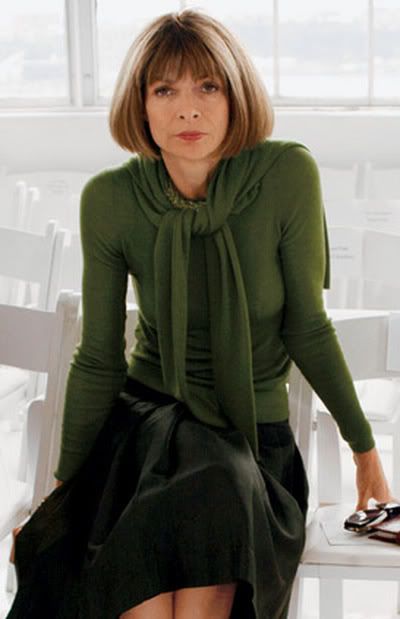
Анна Винтур - главный редактор журнала о моде номер №1 в мире, образец для подражания редакторам всех остальных журналов; безгрешна до того, что её называют "дьяволом", спокойна до того, что её называют "стервой". Её сравнивают с Жаклин Кеннеди-Онассис и Екатериной Великой; она икона для тех, кто мечтает об успехе, идеальная женщина ХХI века - без страха, упрека, возраста и чувств.
Нет, действительно, если разбираться, чем все-таки берет эта пожилая дама, выясняется: тем, что ее ничто не берет. Анна Винтур - киборг, последнее достижение японских программистов или британских генетиков, железный дровосек, как хотите. Будучи императрицей современной моды на протяжении почти 20 лет, Винтур не стала жертвой побочных эффектов: не раздобрела, не окружила себя десятками фаворитов, не засиживается допоздна на светских вечеринках, не тронулась умом - сплошные "не" И только одно "но". Но как? Чудо. Тайна. Авторитет. "Она самая страшная женщина во всем мире", - сказал один итальянский дизайнер. Что касается американцев, то там давным-давно выражение "в стиле Vogue" означает "в стиле Винтур". И быть в этом стиле гораздо важнее, чем иметь новое платье от Prada (хотя одно подразумевает другое), потому что любой амбициозной особе, алчущей места под солнцем, так неудобно и так ненужно быть человечной.
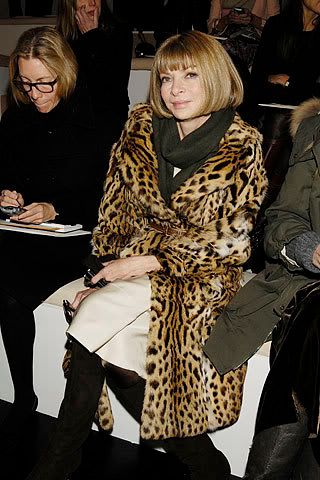

Анна Винтур родилась в Лондоне 3 ноября 1949 года. Её мать, Элеонора, дочь гарвардского профессора, занималась общественной деятельностью. Отец, Чарльз Винтур, был редактором лондонской газеты The Evening Standard. Маленькая Анна души в нём не чаяла и никак не могла понять, почему в журналистских кругах её доброго и нежного папочку называют "Холодный Чарльз". Знай она наперёд, что сама станет обладательницей таких лестных прозвищ, как "кухонные ножницы" или "необычайно гламурное насекомое", то наверняка переживала бы гораздо меньше.
Юную Винтур часто упрекали в чрезмерном увлечении собственной персоной. Отец был первым, кто усмотрел в этом увлечении профессиональную перспективу. Когда Анне было лет десять и вопрос школьной анкеты о будущей профессии поставил её в тупик, Чарльз посоветовал: "Напиши, что ты хочешь стать редактором VOGUE". Именно так она и поступила. В смысле - написала, что обязательно станет редактором VOGUE, а через одиннадцать лет сделала первый шаг по карьерной лестнице мира haute couture. В 1970 году, решив не поступать в колледж, Винтур устраивается ассистентом отдела моды в британский Harper's Bazaar. Через пару лет она уже заместитель редактора, в 1976 - редактор моды американского Harper's Bazaar, а в 1983 - креативный директор американского VOGUE.
В то время главный журнал о моде переживал свои "бежевые годы". Едкая, но предельно точная метафора: бежевыми были стены в кабинете тогдашнего редактора Грейс Мирабеллы, скучными и консервативными - страницы флагмана мировой моды. Руководство ценило старания Винтур в должности креативного директора и догадывалось об её амбициях, но расстаться с Мирабеллой, которая провела у штурвала 17 лет, не решалось. Во избежание недоразумений Винтур даже отправили в Англию, где ей было вверено руководство британским VOGUE и журналом House & Garden. Последний она тут же переименовала в H&G, разбавив скучные интерьеры моделями в дизайнерской одежде и фотографиями знаменитостей. Результат превзошёл все ожидания: редакция была вынуждена выделить отдельную линию, чтобы справиться со звонками негодующих читателей.
Инновации попали на неблагодатную почву, но Винтур от этого только выиграла. Встряхнув House & Garden, она доказала, что способна вдохнуть новую жизнь в журнал, который нуждался в этом более всего. В 1988 Грейс Мирабелла была смещена с поста главного редактора американского VOGUE, на пьедестал победно взошла Анна Винтур.
Революция VOGUE началась с основательной "подтяжки" лица: ряды однотипных блондинок потеснили новые героини - Шерил Тиггс, Пэтти Хэнсен, Ким Алексис. В фокус стали брать непосредственно тело модели, а традиционные для глянцевых обложек студийные фотографии были фактически вытеснены съёмками al fresco. Дебютную обложку Винтур украсила 19-летняя израильская модель в потёртых джинсах за 50 долларов и в топе Christian Lacroix, расшитом драгоценными камнями.
Винтур ломала стереотипы один за другим. Доказав, что мода - это не что иное, как игра, она установила свои правила и заставила весь fashion-мир следовать им.
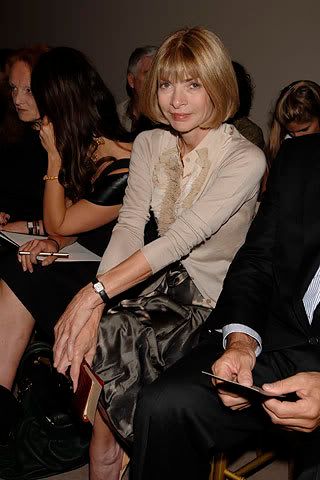

Правило №1: хочешь блистать на страницах VOGUE - избавься от лишнего веса. Американской телезвезде Опри Уинфри пришлось, например, сбросить 9 килограммов.
Правила №2: Если в последний момент редактор решит, что ты не в духе VOGUE - смирись и найди в себе силы жить дальше. В 1999 году Винтур взглянула на пробную фотосъёмку Дженнифер Лопес и в обложке ей отказала. Вердикт: "Слишком вульгарна!" Приговор окончателен и обжалованию не подлежит. Точка.
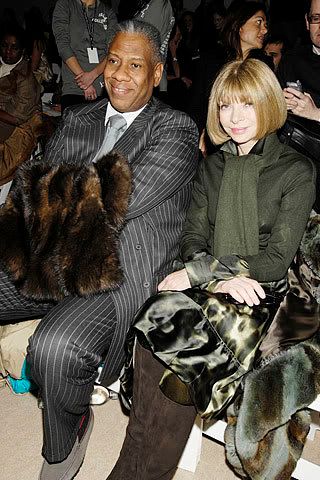
Анна Винтур и Андре Леон Телли, шеф-редактор американского Vogue
МОДНЫЕ ВОЙНЫ
Многие модные журналисты отказываются брать в руки ручку, пока она не начнет писать, без нее показы просто не начинают. Или даже заканчивают раньше - в прошлом году она на три дня сократила Парижскую Неделю моды, потому что не хотела задерживаться в Париже слишком долго; в результате показы начинались в 8.45 утра и проходили по 13 штук в день.
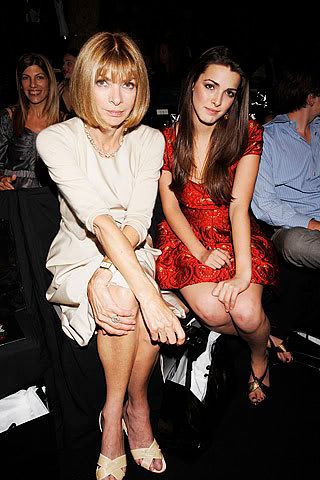
Анна с дочерью Би Шаффер

... и с Грейс Коддингтон
На неделях моды есть своя иерархия: на вершине - главные редакторы модных журналов, среди которых Vogue - номер один, потом байеры, потом стилисты, а журналисты - увы и ах! - на последнем месте. Винтур выгодно отличается от них уже тем, что редко носит черное (не считая очков от Chanel); белый, бежевый, замша, меховые горжетки, за которые ее так ненавидит РЕТА , и бесконечная Prada, за которую ее так любят все прочитавшие "Дьявол носит Prada". С этой "прадой" вышла дурацкая история - Анна оказалась всего лишь на расстоянии трех стульев от никому неизвестной барышни, сидевшей в точно такой же, как у нее, золотой парчовой юбке от Prada. На следующий день госпожа главный редактор заявилась в точно такой же комплектации - золотая юбка и бежевый кардиган, мол, я не ошиблась, когда надела Prada, я всегда ее надеваю, а вы? Она сумеет найти из критической ситуации такой выход, какой простая смертная придумает уже дома, после шестичасового разговора с подругой, а может, и не придумает никогда. По иронии судьбы в 2005 непреклонная редакторша и отверженная поп-дива JLo оказались по одну сторону баррикад, став объектами нападок со стороны защитников животных. Дженнифер Лопес расплачивается за свою новую линию одежды Sweetface, в которой используется натуральный мех. А Анна Винтур - за одержимость "мягким золотом", активную его пропаганду и отказ публиковать даже оплаченную анти-меховую рекламу. В знак протеста зверозащитники неоднократно атаковали Винтур сливочными тортами и тиражировали её фотографии под слоганом - "Мех носят прекрасные животные и уродливые люди!". Не известно, как вела себя J.Lo, но Винтур плевать хотела на подобные провокации. "Носите больше меха!" - заявила она, вытирая с лица торт. Очередное "покушение" состоялось прямо на показе Chanel.
А когда в ресторане активисты по борьбе за права животных вывалили ей на тарелку мертвого енота, она холодно попросила официанта убрать тарелку с посторонним предметом и продолжила трапезу.
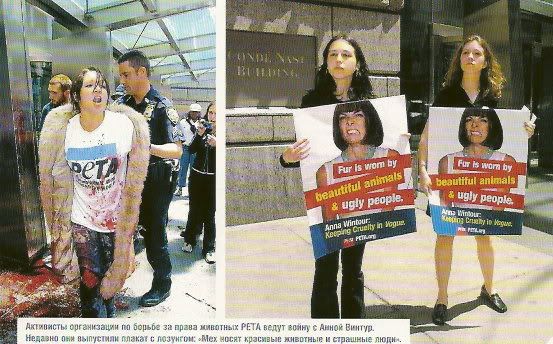
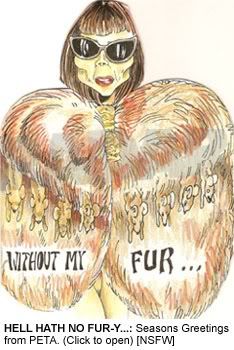
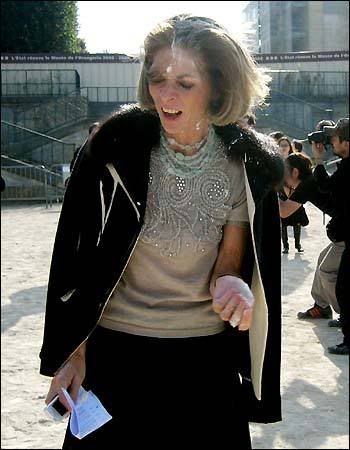
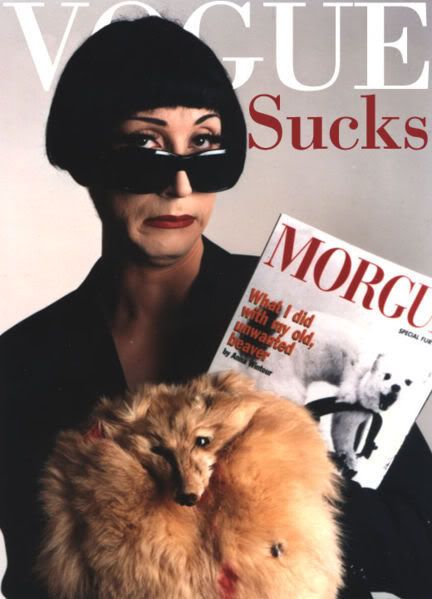
Anti-Wintour image created and distributed by PETA to protest her continued promotion of fur in fashion.
ЖЕЛЕЗНЫЕ ПРАВИЛА
Отъявленный трудоголик с имперскими замашками, Винтур славится тем,. что за всю свою жизнь ни разу не отступила от установленного ею для себя режима. Ключевые слова - "не отступила". Право на режим имеет каждый, но не отступать? Она не пьет, не задерживается на вечеринке дольше 20 минут, ложится спать в 10 вечера, чтобы встать утром в 5.45. Чашка кофе, теннис, в 7.00 приходят визажисты, стилисты и парикмахеры - и начинается ... Терпеть не может дамские сумочки, почти всегда носит тёмные очки от Chanel и каждую минуту своей жизни выглядит так, как будто собирается выступать перед многомиллионной аудиторией. Говорят, когда ей нужно сделать фотографию на паспорт, она приглашает Энн Лейбовиц или Давида Лашапеля.
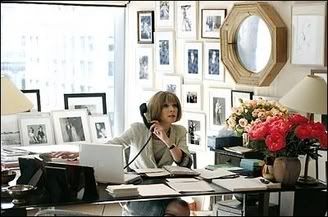
Анна в своем кабинете
В редакции она установила свод негласных правил. Никакой еды! Младшие сотрудники не должны заговаривать со старшими, пока к ним не обратятся. Один из сотрудников сдуру поприветствовал начальницу, когда столкнулся с ней в лифте, и получил персональный выговор от одного из ее личных ассистентов. Другой метался, не зная, как поступить, увидев, что шеф растянулась в коридоре, зацепившись шпилькой за ковер, и в итоге просто прошел мимо. Позже ему передали, что он поступил абсолютно правильно. Свита уверяет, что по незнанию люди истолковывают робость Анны как высокомерие. Не смешите. Vogue рассматривают как пансион благородных девиц для девушек из хо роших семей. "Wintour's girls" априори стройные, миловидные и со вкусом одетые. Как-то Анна проговорилась журналисту, что не возьмет на работу толстую барышню, каким бы гениальным редактором она ни была, и не будет испытывать угрызений совести. "Для меня очень важно, чтобы люди, которые работают здесь, особенно в отделе моды, подавали себя таким образом, чтобы посторонние сразу понимали - они из Vogue".
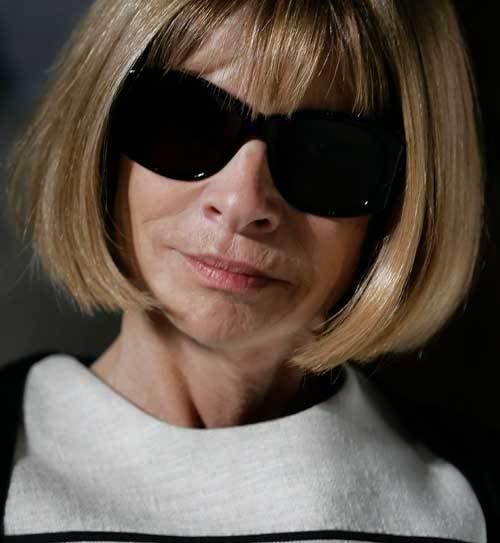
Сама Винтур зарабатывает около миллиона долларов в год, не считая щедрых "чаевых": 25 тыс. долларов - "паёк" на одежду, машина с шофером, бесплатные путешествия на все европейские показы, номер в Ritz. Каждое Рождество отдел аксессуаров сходит с ума, подыскивая подарки для друзей, семьи и любимых рекламодателей Винтур. Точнее сходит с ума тот один, кого выбирают ответственным, а все остальные ему сочувствуют.
ЛИЧНЫЕ СЧЕТЫ
"Она позиционирует свой журнал как мост между дизайнерами и потребителями", - говорит Донна Кэран. 10 лет назад, когда мир захватил стиль "гранж", Анна Винтур потребовала ни на шаг не отступать от гламура и лично обратилась к дизайнерам: вот что мы хотим снимать. Если вы такого не делаете, мы снимать не будем. Винтур без посторонней помощи ускорила карьерный рост Майкла Корса и Марка Джейкобса. Она признается, что, выбирая между двумя равными платьями, она выберет то, которое принадлежит наиболее выгодному для нее рекламодателю. "Коммерция для меня не грязь", - любит повторять она.
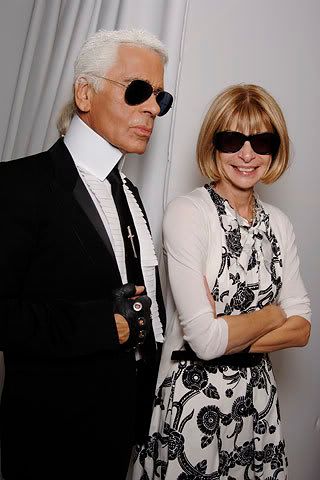
Анна с Карлом Лагерфельдом
Почти 8 лет ее правой рукой была Кэйт Беттс. Одинаково талантливая и отчаянная, Беттс пыталась выйти на другой уровень, писала жесткие истории об уличной культуре и моде, о роли женщины в политике, о финансовых мучениях топ-дизайнеров, о новом поколении. Анне казалось, что подобные темы ниже уровня Vogue, но ей нравилось, что у Кэйт хватало духу с ней спорить. "У нее всегда было свое мнение, она не серая мышь, да и что за смысл сидеть здесь со стадом мышей!? Мне нужны личности!" - уверяла Винтур. Личность она стравила с молодой фавориткой из Англии Плам Сайкс, наслаждаясь их совместной работой, зная, что Кэйт презирает Плам, а Плам ненавидит Кэйт. Беттс ушла в Harper's Bazaar, отклонив предложения Изда тельского дома Conde Nast стать редактором и Details, и Mademoiselle или просто удержаться в Vogue, "пока не освободится должность главного". В то время как все сотрудники, восхищаясь мужеством Кэйт, обнимали ее и поздравляли, Винтур ограничилась сухим "Good luck", зато в следующем же письме редактора отписала Кэйт Беттс нежные напутствия и даже поместила ее фотографию. Кэйт не ответила взаимностью. Мельком, со своей тонкой улыбкой, Винтур как-то обронила: "Я всегда знала, что Кэйт хочет стать главным редактором, и мне бы это понравилось, но, я прошу прощения, не в Conde Nast".
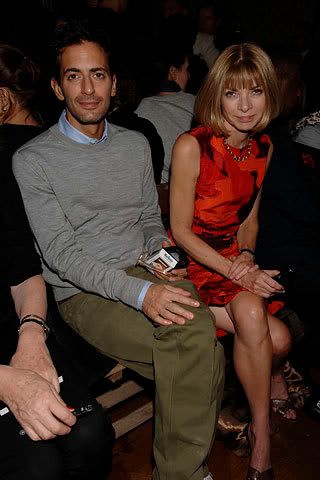
Анна с Марком Джейкобсом
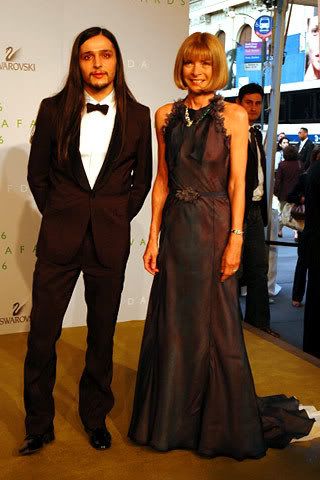
... и с Оливье Тискенсом
БЛИЗОСТЬ
Накануне ХХI века ледяной фасад диктатора начал таять. С безупречным прошлым, безу пречным настоящим и блестящим будущим (которое никогда не наступит, потому что безупречное настоящее будет длиться вечно), Анна Винтур была поймана за вполне человеческим занятием - интрижкой с женатым мужчиной. Причем, опять же, ключевым словом является "поймана". Ее фамилия и фамилия Шелби Брайана, телефонного магната, мелькали во всех таблоидах. Муж Анны, известный детский врач, в браке с которым она прожила 15 лет и которому родила двоих детей, позвонил супруге Брайана Кэтрин и сказал: "Привет, у меня хорошие новости: твой муж и моя жена трахаются друг с другом". Шелби пообещал жене, что больше так не будет, и даже подарил ей новое кольцо. Винтур, изображавшая на официальных мероприятиях исступленное оживление, ковыряла пол каблуком "блаников", отказывалась от комментариев или отсылала всех к своему помощнику.
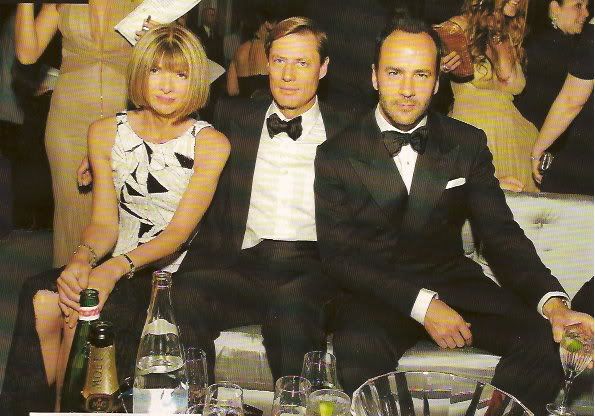
Анна с мужем Дж. Шелби Брайаном и Томом Фордом
Для сотрудников Империи Vogue все было очевидно уже давно: она закрывала дверь во время телефонных разговоров, задерживалась на ланчах дольше обычного, а ее прическа... стала не такой безупречной, как всегда. Новички вроде In Style и Marie Claire, воспользовавшись моментом, стали кусать Vogue за пятки, а председатель Conde Nast Си Ньюхауз начал поговаривать, что теряет уверенность в своей "золотой девочке". Друзья были уверены, что Анна подаст заявление об уходе. Самое интересное разворачивалось на показах. Винтур по-прежнему была обязана сидеть в первом ряду, чего ей, видимо, не очень хотелось. "Это как автокатастрофа, все происходит на твоих глазах, но ты ничем не можешь помочь, - сказал один из ее ассистентов. - Но вот что странно: основной кипеж подняли из-за того, что ее поймали на чем-то ... человечном".
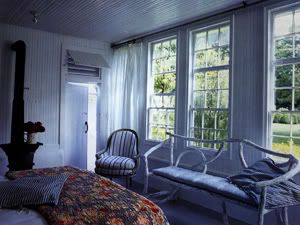
Дом Анны Винтур в Хэмптонсе
Сама Винтур, подав на развод, съездила в теплую Грецию и ... снова стала ледяной: "О, вы знаете, моя семья и мои друзья знают, что происходит на самом деле, и если весь остальной мир думает как-то иначе, я просто не обращаю внимания".
Говорят, сейчас Винтур увлеклась политикой, поместила на обложку Хилари Клинтон, а остальные страницы забросала материалами о Мадлен Олбрайт, Лии Рабин и других политических львицах. Она занимается интернет-версией Vogue с подростковым рвением, хотя признается, что все еще с трудом сама отправляет банальный e-mail. Недавно, она распорядилась создаваемому на сайте журнала блогу придумать более подходящее название. Слово "блог" она ненавидит и не желает видеть его на сайте. Правда, источник из окружения Винтур уверяет, что она не хочет называть блог блогом, поскольку это не будет блог, то есть, ей бы не хотелось, чтобы люди относились к этому блогу как к блогу, поэтому создаваемый блог надо назвать как-нибудь иначе. Волшебная женщина Оступившись и удержав равновесие, королева стала королевой в квадрате. Это как с породистыми лошадьми настоящие знатоки всегда ищут лошадь с изъяном: например, абсолютно черную - с белым пятнышком, чтобы еще больше подчеркнуть черноту.
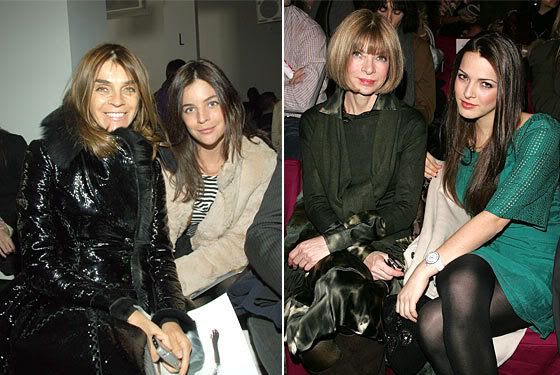
Карин Ройтфейльд, главный редактор французского Vogue, с дочерью и Анна Винтур с дочерью Би Шаффер
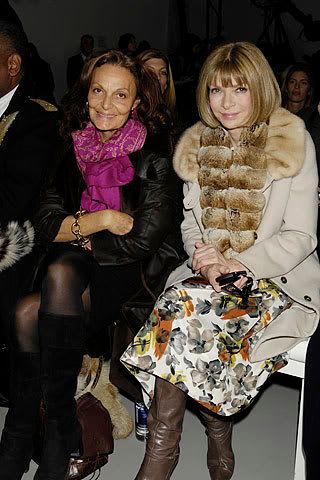
Анна с Дианой фон Фюрстенберг
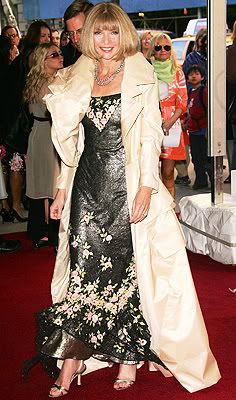

The message: if anyone deserves to be compared to a crazed monster it is the notoriously demanding Wintour, with her ostensible boss Si Newhouse along for the ride. The illustration, by Victor Juhasz, capped a rough few months for Wintour, who was publicly dissed by fashion's priesthood during a recent trip to Europe, then faced uproar over her recent weight-loss outreach to two female designers and is now grappling with fallout from the James cover.
В 2003 году Анна Винтур получила награду за большой вклад в развитие моды. На церемонии главный редактор VOGUE появилась в нежно-персиковом платье от Оскара де ла Рента - не в пример прочим fashion-акулам, предпочитающим чёрный. Подчёркнуто элегантна и очень женственна - так, как подобает женщине её возраста и статуса. Злой гений?! Фея, которая зажигает одни звёзды, а другим перекрывает кислород?! А может, ей просто завидуют?! Хотя бы потому, что далеко не каждому полагается 25 000 долларов ежегодной надбавки к и без того миллионной зарплате - так, на всякие женские штучки...


постер фильма Дэвида Франкеля "Дьявол носит Prada"
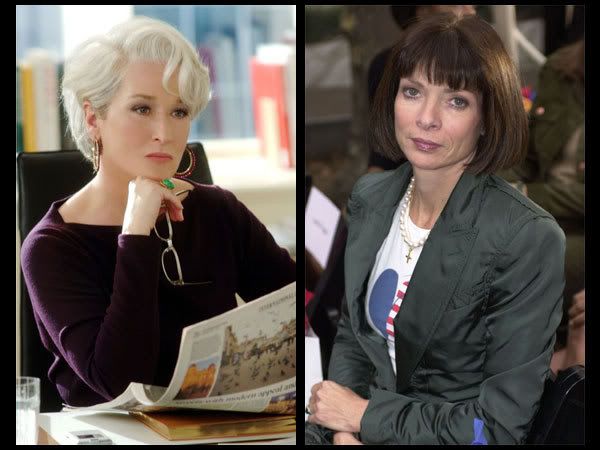
Мерил Стрип в роли Миранды Пристли и её прототип

Вряд ли кто то, кроме меня, верит, что иногда Винтур засиживается по вечерам за игрой в шашки, а по утрам просыпает к чертям свой теннис и корчит потом в ванной себе рожи, бубня: "Ужас, какая же я старая - как моя зубная щетка! Вот черт, опять забыла купить себе новую зубную щетку ... " Ну, или что-нибудь в этом роде. Не колют же ботокс в сердце!
Ссылки:
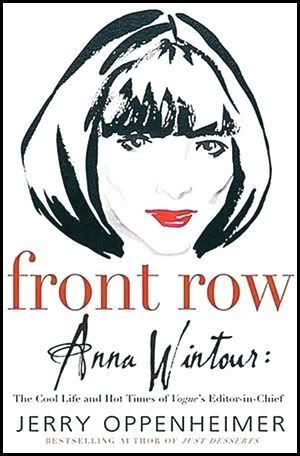
КНИГА ДЖЕРРИ ОППЕНХЕЙМЕРА "FRONT ROW:ANNA WINTOUR:THE COOL LIFE AND HOT TIME OF VOGUE'S EDITOR IN CHIEF"
Anna Wintour
From Wikipedia, the free encyclopedia
Anna Wintour (born November 3, 1949) is the Editor-in-Chief of the U.S. edition of Vogue, a position she has held since 1988. A native Londoner of English and American parentage, she became interested in fashion as a teenager and advised her father Charles, editor of the Evening Standard, on how to better make the newspaper appealing to the youth of mid-1960s Britain. After dropping out of school at 16, she forsook college to start a career in journalism on both sides of the Atlantic that stopped at New York and Home & Garden before she took over at British Vogue and finally the flagship magazine in New York. She succeeded in turning around a faltering product and has been widely recognized in the publishing industry for her success.
Like her predecessor Diana Vreeland, she has become a fashion icon in her own right. Her bob haircut and sunglasses have become a common sight in the front row of the most exclusive fashion shows.
She has become as much of an institution in the fashion world as the magazine she edits. Universally hailed for her keen eye for fashion trends and support for younger designers, her aloof and demanding persona has earned her the nickname "Nuclear Wintour". A former personal assistant of hers, Lauren Weisberger, wrote the 2003 bestselling roman a clef The Devil Wears Prada, later made into a successful film starring Meryl Streep as Miranda Priestly, a fashion editor widely believed to be based on Wintour. She has also drawn both praise and criticism for her willingness to use the magazine and its cachet to shape the industry as a whole. Animal rights activists have also singled her out for her continued promotion of fur.
Family
Her father, Charles Vere Wintour, CBE, was a former editor of The Evening Standard. Her mother was Wintour's first wife, Eleanor ("Nonie") Trego Baker, the daughter of a Harvard law professor, whom he married in 1940 and divorced in 1979. She was named after her maternal grandmother, Anna (Gilkyson) Baker, a Philadelphia socialite.Her stepmother is Audrey Slaughter, a magazine editor who founded such British publications as Honey and Petticoat.
Wintour had four siblings, three of whom survive: James Charles, the managing director of Gravesham Borough Council;Nora Hilary Wintour, the deputy general secretary of Public Services International in Geneva, Switzerland; Patrick Wintour, who started as labour correspondent at The Guardian in 1983 and rose to become the political editor for both it and the The Observer in 2006. Her eldest brother, Gerald Jackson Wintour, died as a child in 1951 when he was struck by a car.
Her aunt Cordelia Wintour married Sir Eric James, who was granted a life peerage as Baron James of Rusholme.
Early life
The young Wintour was educated at North London Collegiate School, where she frequently rebelled against the dress code by wearing her skirts so that the hem was higher than allowed. At the age of 14 she began wearing her hair in the bob that has since become her trademark. As London began to swing, she became a dedicated follower of fashion as a regular viewer of Cathy McGowan on Ready Steady Go!, and her father regularly consulted her when he was considering ideas for increasing readership in the youth market. In her later teens, she began dating gossip columnist Nigel Dempster and became a fixture on the London club circuit with him.
Career
From fashion to journalism
At 16, Anna dropped out of North London Collegiate. Wintour chose not to go to college but instead entered a training program at Harrods. At her parents' behest, she also took some fashion classes at a nearby school, but soon dropped out, telling her friend Vivienne Lasky that "you either know fashion or you don't". At Harrod's, she continued dating well-connected older men, in this case Peter Gitterman, the stepson of London Philharmonic Orchestra conductor Georg Solti.
She entered the field of fashion journalism in 1970 when Harper's Bazaar merged with Queen to become, for a time, Harper's & Queen. There, she discovered model Annabel Hodin, a former North London classmate, and used the connections she had built up to secure locations for some striking, innovative shoots.One recreated the works of Renoir and Manet using models in go-go boots.After a short stint at a small magazine named Savvy,Wintour would move on to become a junior fashion editor at Harper's Bazaar in New York in 1975,where she lasted less than a year before being fired.[citation needed] Anna went on to become editor in charge of fashion at Viva.According to Jerry Oppenheimer's biography Front Row, she would later omit mention of the magazine in her career because of its connections to Penthouse. After three years, she moved on to become fashion editor of New York.
British Vogue
She became editor of British Vogue in 1986 and House & Garden the following year. At the former, she told her father's old paper, the Evening Standard, she wanted to reach "a new kind of woman out there. She's interested in business and money. She doesn't have time to shop anymore. She wants to know what and why and where and how."
At the latter, she was so fond of putting couture in photo spreads that industry wags began to refer to the magazine as House & Garment.She managed to turn around and increase circulation of British Vogue but her couture photo spreads turned off subscribers to House & Garden such that it would eventually close down after she left. "She destroyed House & Garden in about two days," complained a fired editor, noting that she had, in her first week, killed phot spreads and articles that had cost $2 million.(later, it would be revived by its parent company, Conde Nast).
American Vogue
She was expected to do the same at American Vogue, when she took over in 1988. It had, under her predecessor Grace Mirabella, become more focused on lifestyles as a whole and less on fashion. Industry insiders worried that it was losing ground to the upstart ELLE, which had been introduced to America from France in 1985. Wintour made her mark early on with a shift in the cover pictures. Whereas Mirabella had preferred tight headshots of well-known models, Wintour's covers showed more of the body and were taken outside, in natural light, instead of the studio, echoing what Vreeland had done years earlier. She used less well-known models, and mixed inexpensive clothes with the high fashion - the first issue she was in charge of, in November of that year, featured a young Israeli model in a $50 pair of faded jeans and a bejeweled T-shirt by Christian Lacroix worth 200 times that (200 x $50 = $10,000). Eight months later, another model was shown in wet hair, with just a terrycloth bathrobe and apparently without makeup.She also made a point of seeing to it that photographers, makeup artists and hairstylists got as much credit for the images as the models.
Under her editorship, the magazine renewed its focus on fashion and returned to the prominence it had held under Diana Vreeland. The September 2004 issue boasted a record 832 pages, the largest issue of a monthly magazine ever published at that time.She has also overseen the introduction of three spinoff titles: Teen Vogue, Vogue Living and Men's Vogue. Teen Vogue has outpaced its two top competitors, ELLE Girl and Cosmo Girl in ad pages and dollars, and the 164 ad pages in the debut issue of Men's Vogue were the most for a first issue in Conde Nast history.Her accomplishment in expanding the brand earned her the coveted title of "Editor of the Year," by the industry trade magazine AdAge.
Her salary is reported to be $5 million a year and she also receives generous perks including a $50,000 clothes budget, a chauffeur and a suite at the Hotel Ritz Paris whilst attending Paris Fashion Week.[citation needed]A & E IndieFilms and R.J. Cutler are to shoot a feature-length documentary chronicling the making of Vogue's September issue. Cutler had approached Wintour in 2004 and will direct the untitled pic which will be shot over eight months as Wintour prepares the fall fashion issue, known in the industry as the "fashion bible". The filmmakers plan to have the pic completed in 2008
Fashion industry power broker
Anna Wintour, through the years, has become one of the most powerful people in fashion, setting trends and anointing new designers. The Guardian has called her the "unofficial mayoress" of New York City.She has worked behind the scenes to encourage fashion houses to hire younger, fresher designers such as John Galliano, who owes his position at Christian Dior to her intervention. She persuaded Donald Trump to let Marc Jacobs use a ballroom at the Plaza Hotel for a show when he and his partner were short of cash. More recently, she persuaded Brooks Brothers to hire the relatively unknown Thom Browne Her protegee at Vogue, Plum Sykes, became a successful novelist, drawing her settings from New York's fashionable elite.
Like many successful power brokers, she rarely makes her wishes known directly. Fashion industry publicists say that a simple "Do you want me to go to Anna with this?" from a subordinate is often enough to settle a dispute in Vogue's favor.
Personal life
Marriages and children
She married child psychiatrist David Shaffer in 1984and has two children by him, Charles (Charlie) and Katherine (known as Bee), who blogs for the Daily Telegraph (during both pregnancies, she continued to wear Chanel miniskirts to work).
The couple divorced in 1999; tabloid newspapers and gossip columnists speculated that it was an affair with millionaire investor Shelby Bryan that ended the marriage, but Wintour has refused to comment.[citation needed] She maintains an ongoing relationship with Bryan that friends say has mellowed her. "She smiles now and has been seen to laugh", the Observer quoted one as saying.
Philanthropy
Despite her infamous icy facade, Wintour is also a noted philanthropist. She serves as a trustee of the Metropolitan Museum of Art in New York.Wintour began the CFDA/Vogue Fund in order to encourage, support and mentor unknown fashion designers. She has also raised over $10 million for AIDS charities since 1990, by organizing various high profile benefits.
Work habits
She rises daily before 6 a.m., plays tennis and has her hair and makeup done, then gets to Vogue's offices at 8. She always arrives at fashion shows at their scheduled starting time, whether or not they can be reasonably expected to do so. "I use the waiting time to make phone calls, make notes; I get some of my best ideas at the shows", she says. According to the BBC documentary Boss Woman, she is similarly efficient with her time elsewhere in her day, rarely staying at parties for more than 20 minutes at a time and getting to bed by 10:15 every night.
At Vogue, she reportedly has three full-time assistants (one more than suggested by The Devil Wears Prada) but sometimes surprises callers by answering the phone herself. Her good friend Barbara Amiel says that she often turns her cell phone off in order to eat lunch uninterrupted, and likes to have a good steak for her midday meal.
Politics
"Anna is a liberal", says Amiel. "She endorsed Al Gore in his presidential bid".
Criticism
While her success at turning Vogue around and her support of the fashion industry and charity work are universally acknowledged, that has not immunized her from criticism.
In 2003, one of her former assistants, Lauren Weisberger, published the bestselling roman a clef The Devil Wears Prada. Its antagonist, Miranda Priestly, editor of the fictional Runway, was widely believed to be based on Wintour.
Two years later, Wintour was the subject of an unauthorized biography by Jerry Oppenheimer, Front Row: The Cool Life and Hot Times of Vogue's Editor In Chief, that drew on many unnamed sources, often with grudges, to paint a similar portrait of the real woman. According to Oppenheimer, Wintour not only declined his requests for an interview but directed others not to cooperate.This is consistent with reports that she goes to great lengths to manage her public image. When she took over as American Vogue editor, gossip columnist Liz Smith reported rumors that she had gotten the job by having an affair with Conde Nast chairman Si Newhouse. Wintour was reportedly furious and made her anger the subject of one of her first staff meetings.
There have also been accusations that she has imposed an elitist aesthetic on the magazine, promoting celebrities over fashion personalities and making demands that even prominent subjects change their image before being featured in its pages.
Personality
Accounts of her personality often describe it as cold. In his autobiographical comedy "How to Make Enemies and Alienate People", British journalist Toby Young nicknamed her "Nuclear Wintour" for her icy demeanour and alleged mood swings during her tenure at British Vogue, an epithet that has been widely reused
"I think she has been very rude to a lot of people in the past, on her way up - very terse.", said the same friend the Observer quoted on the positive effect of her relationship with Bryan. "She doesn't do small talk. She is never going to be friends with her assistant". "You definitely did not ride the elevator with her", agrees a former assistant.[24] Even those who like her admit to some trepidation at her presence. "Anna happens to be a friend of mine," says Amiel, "a fact which is of absolutely no help in coping with the cold panic that grips me whenever we meet".
She has just as often been described as a perfectionist who routinely makes impossible, arbitrary demands of those who work for or under her and treats them unkindly ... "kitchen scissors at work", in the words of one commentator. "The notion that Anna would want something done 'now' and not 'shortly' is accurate," Amiel says of The Devil Wears Prada. "Anna wants what she wants right away". She reportedly once made a junior staffer look through a photographer's trash to find a picture he had refused to give her. In a frequently-retold story, a new intern at the magazine is told she must not make eye contact with Wintour or initiate conversation with her. One day in the hall, the intern sees Wintour trip and steps right over her rather than violate this taboo.
Critics of Wintour's management style also point to a May 11, 2004 ruling by a New York court in a case brought against Wintour and Shaffer by the state Workers' Compensation Board. It sought to recover $140,000 in costs it had incurred when a former employee of the couple who had been injured on the job turned out not to have had the necessary insurance coverage. Wintour and Shaffer repeatedly failed to make payment, forcing the suit. The two were ordered to pay $104,403; an additional $32,639 was levied against Wintour herself.
Lauren Weisberger's roman a clef, The Devil Wears Prada, supposedly about Wintour and Vogue.
The Devil Wears Prada
Weisberger's novel is told in the voice of Andrea "Andy" Sachs, a young woman fresh from college with literary ambitions who knows little about fashion when she starts a year at Runway magazine, working as the junior assistant to legendary editor Miranda Priestly, who among her other similarities to Wintour is British, has two young children and serves on the Met's board. Priestly is depicted as a tyrant who makes impossible demands of her subordinates, gives them almost none of the information or time necessary to comply and then berates them for their failures to do so.[26] Similar charges have long been made about Wintour herself by (usually unnamed) former employees. Prior to its publication, Wintour told the New York Times, "I always enjoy a great piece of fiction. I haven't decided whether I am going to read it or not."[27]
While it has been suggested that the setting and Priestly were based on Vogue and Wintour, Weisberger denies this, and even gives Wintour herself a cameo appearance near the end of the book (In her less-successful second novel, Everyone Worth Knowing, the main character doesn't think she's capable of working for Wintour when her uncle suggests it.
Yet it is almost universally believed that the book's success was due to the real-life angle. Neither Vogue nor any other Conde Nast publications, nor many other popular women's magazines, reviewed Weisberger's book. When the film was released, one of the company's magazines, The New Yorker, ran a review of the film by David Denby that disparaged the novel in comparison.The New York Times's Janet Maslin avoided mentioning Wintour's name in one of the paper's two negative reviews of the book. Its favorable notice of the movie mentioned neither Vogue nor Wintour.
Film adaptation
During production of the movie in 2005, Wintour was reportedly pressuring prominent fashion personalities, particularly designers, not to make cameo appearances in the movie lest they be banished from the magazine's pages, at least temporarily.She denied it through a spokesperson who said she was interested in anything that "supports fashion". But, while many designers are mentioned in the film, only one, Valentino Garavani, actually appeared as himself.
The film was released, in mid-2006, to great commercial success. Wintour attended the premiere wearing Prada. In the film, actress Meryl Streep plays a Priestly different enough from the book's to receive critical praise as an entirely original (and more sympathetic) character (although Streep's office in the film bears similarities striking enough to Wintour'sthat the latter reportedly had it redecorated after the film's release. Streep denies that her portrayal was based on Wintour, whom the actress says she only met at the first benefit screening of the film. She stated she had no interest in doing a documentary on the Vogue editor, preferring to draw her inspiration from an amalgam of uberbosses she had met over the years.
Amiel reported that her first reaction was to say that the film would probably go straight to DVD.It went on to make over US$ 300 million in worldwide box office receipts. Later in 2006, in an interview with Barbara Walters which aired the same day the DVD was released, Wintour said she found the film "really entertaining" and praised it for making fashion "entertaining and glamorous and interesting.... I was one hundred percent behind it".
While Wintour may have borne no malice toward the film and those involved in it, the same may not be true regarding Weisberger. When Daily News gossip columnist Lloyd Grove reported shortly before the film's release that the author was having enough trouble with her third novel (after disappointing sales of her second) that her editor suggested she completely start over, there was enough bitterness left that Wintour's spokesman Patrick O'Connell suggested she "should get a job as someone else's assistant."
PETA campaign
She has often been the target of various animal rights organizations such as PETA who are angered by her use of fur in Vogue, her pro-fur editorials and her refusal to run paid advertisements from animal rights organizations. Undeterred, she continues to use fur in photo spreads. She is routinely assaulted by activists over this matter.
In Paris in October 2005, she was hit with a tofu pie while waiting to get into the Chloe show.She herself said she has been physically attacked so many times she's "lost count."[citation needed] She and Vogue's publisher Ron Galotti (himself the inspiration of a fictional character as Mr. Big from Sex and the City) once retaliated for a protest outside the Conde Nast offices during the company's annual Christmas party by sending down a plate of steaming, freshly cooked roast beef.
Elitism
Some critics have charged that instead of models, celebrities are becoming the face of Vogue.[citation needed] Indeed, a wide range of prominent women have graced the front cover of Vogue during Wintour's tenure, from Oscar-winning actresses (Nicole Kidman, Charlize Theron, and Angelina Jolie) to celebrities (Melania Trump and Kate Winslet) and politicians (Hillary Clinton).
According to insiders, however, she has not been content to let celebrities appear on the cover, but has demanded they bow to her standards as well. Oprah Winfrey was reportedly told she would not be photographed for the cover until she lost weight, and Clinton would not appear until she stopped wearing navy blue suits as much as she had been. At the 2005 Anglomania celerbation, a Vogue-sponsored salute to British fashion at the Met, Wintour is said to have gone beyond mere approval and personally chose the clothes that prominent attendees such as Jennifer Lopez, Kate Moss, Donald Trump and Diane von Furstenberg wore. "I don't think Vreeland had that kind of concentration", says Women's Wear Daily publisher Patrick McCarthy. "She wouldn't have dressed Babe Paley. Nor would Babe Paley have let her".
Another writer for the magazine complained that Wintour excluded ordinary working women, many of whom are regular subscribers, from the pages. "She's obsessed only about reflecting the aspirations of a certain class of reader," the writer says." "We once had a piece about breast cancer which started with an airline stewardess, but she wouldn't have a stewardess in the magazine so we had to go and look for a high-flying businesswoman who'd had cancer."
Wintour has been accused of exercising her power to set herself apart even from ostensible peers. "I do not think fiction could surpass the reality", an unnamed British fashion magazine editor says of The Devil Wears Prada. "[A]rt in this instance is only a poor imitation of life." Wintour, the editor says, routinely requests that her seats at New York fashion shows are located such that she is not only separated from competing editors but cannot even see or be seen by them, either.Further,
We spend our working lives telling people which it-bag to carry but Anna is so above the rest of us she does not even have a handbag. She has a limo. And she has her walkers Andre Leon Talley and Hamish Bowles, whose main job is to carry her bits around for her.
Amiel confirms this practice. "Why she has this routine I don't know. Certainly it unnerves females ... Obviously it is part of the persona".
Some of her intercessions on behalf of designers, particularly Georgina Chapman (currently dating film mogul Harvey Weinstein), have also been criticized as being motivated by personal connections rather than talent. By persuading designers to loan clothes to prominent socialites and celebrities, who are then photographed wearing the clothes not only in Vogue but more general-interest magazines like People and Us, which in turn influence what buyers want, some in the industry believe Wintour is exerting too much control over it, especially since she is not involved in making or producing clothes herself. "The end result is that Anna can control it all the way to the selling floor", says Candy Pratts Price, executive fashion director at style.com.
Responses
Wintour has rarely, if ever, personally responded to criticisms of her, as most critics have been her employees or others with something to gain by remaining in her favor. But there have been a few defenses from other quarters. Amanda Fortini at Slate said she was just fine with Wintour's elitism since that was intrinsic to fashion and, ultimately, good for the magazine's readers:
In a sea of women's glossies that purport to be about fashion but publish earnest articles chronicling the author's quest for self-actualization, Vogue stands apart. The voluminous fashion pages are arty, original, and sophisticated, shot by talented photographers like Annie Leibovitz, Irving Penn, and Steven Meisel. Most of us read Vogue not with the intention of buying the wildly expensive clothes, but because doing so educates our eye and hones our taste, similar to the way eating gourmet food refines the palate. This is a pleasure enabled by Wintour's ruthless aesthetic, her refusal to participate in the democratizing tendency of most of her competitors. To deny her that privilege is to deny her readers the privilege of fantasy in the form of beautifully photographed Paris couture.
Responses to horror stories about her treatment of employees have frequently been met with charges of sexism, that similar behavior from a male boss would seem unremarkable. "Powerful women in the media always get inspected more thoroughly than their male counterparts", said the New York Times in a piece about Wintour shortly after the film's release.[40] Wintour has been likened to Martha Stewart and fellow Conde Nast editor Tina Brown, both of whom also have been described as overbearing and abusive to those who work for them.
Some of her defenders have even seen her as feminist whose changes to Vogue have actually in a small way reflected, acknowledged and reinforced advances in the status of women. In a nominal review of Oppenheimer's book in the Washington Monthly, managing editor Christina Larson notes that Vogue, unlike many other women's magazines, doesn't play to its readership's sense of inadequacy:
Unlike its glossy peers on the newsstand, it isn't loaded with tips to flatten your abs, flaunt your cleavage, or squeeze into your thin jeans by Friday; it assumes you need no help mastering love moves no man can resist. It doesn't purport to solve problems, to help you feel less guilty. Instead, it reminds women to take satisfaction, parading all manner of fineries (clothes, furniture, travel destinations) that a successful woman might buy, or at least admire. While it surely exists to sell ads - which it does remarkably well - it does so primarily by exploiting ambition, not insecurity.
She contrasts Vreeland's Vogue with Wintour's by noting how the former treated female beauty as something innate, whereas Wintour showed how it could be created. "She shifted Vogue's focus from the cult of beauty to the cult of the creation of beauty ... Beyond whisking models off their pedestals, the concept that grace is a construction, and not merely a gift, allows that it can be enjoyed longer, well past the age of 40 or 50". To her, the focus on celebrities is a welcome development as it means that women are making the cover of Vogue at least in part for what they have accomplished, not just how they look. "Wintour's Vogue allows women to imagine a world, increasingly an attainable one, in which the pursuit of beauty reinforces rather than overshadows female authority", she concludes.
Concerns about her role as an eminence grise of the fashion world are allayed by those familiar with how she uses that power, who say she is not manipulative. "She's honest. She tells you what she thinks. Yes is yes and no is no", according to Karl Lagerfeld. "She's not too pushy" agrees Francois-Henri Pinault, chief executive officer of PPR, Gucci's parent company. "She lets you know it's not a problem if you can't do something she wants. But she makes you understand that if you could, she would be very supportive with her magazine."
Her defenders also suggest her power over the industry is neither as vindictively applied, nor as absolute, as is often believed. She continued to support Gucci despite her strong belief PPR was making a major mistake letting Tom Ford go. Designers such as Alice Roi and Isabel Toledo have become rising stars in the industry without indulging Wintour or Vogue.
She has also earned praise for her tenacity. "Once a friend, that's it", Amiel quotes Talley as saying, after Wintour helped him overcome a serious weight problem. Amiel herself agrees that "her singular quality is one of loyalty". This carries over into her professional life. Her willingness to throw her weight around has helped keep Vogue independent despite its heavy reliance on advertising dollars. Wintour was the only fashion editor who refused to follow an Armani ultimatum to feature more of its clothes in the magazine's editorial pages if it was running the company's ads.
Even The Devil Wears Prada is not without some admiration for Wintour/Priestly. Weisberger, through Andy, notes that she does manage the difficult task of making all the major editorial decisions in a major fashion magazine every month all by herself and that she does have genuine class and style
In popular culture
* Edna Mode, in the 2004 hit animated film The Incredibles, was believed to have been at least partially inspired by Wintour, due to the similar bob haircut.
* The HBO series Tracey Takes On, starring Tracey Ullman, also featured a similar Anna Wintour character.
* Wintour is referenced in another HBO series, Sex and the City, when Carrie Bradshaw is interviewed for a job at Vogue. Carrie gets drunk with an editor in his Vogue office, who tries to subtly help the tipsy Bradshaw make her way out of the building. On her way she bumps in to a female employee and, embarrassed, says "please tell me that wasn't Anna Wintour".
* Ugly Betty's character Fey Sommers shares some characteristics as Wintour, such as the bob and sunglasses, being the editor of a fashion magazine, and having a last name that sound like a season. Wintour is also referenced in the series after Bradford Meade is arrested and Wilhelmina Slater is poised to take over as Editor-in-Cheif of the magazine. Wilhelmina is informed by her assistant that Wintour called with an invitation to lunch, which Wilhelmina declines.
* There are several references of Anna throughout Robert Altman's 1994 film "Pret-a-Porter"; on the featured fashion shows, fashion critics sitting on the front row wear sunglasses. The fictional fashion editor, Regina Krumm (played by Linda Hunt) has a similar haircut style.